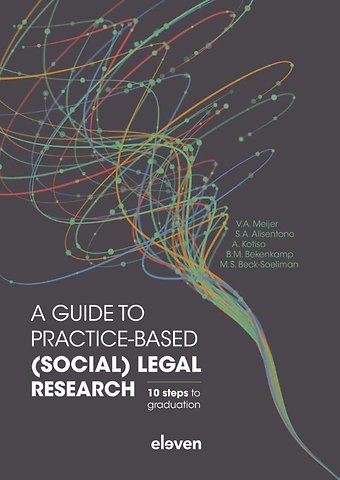A guide to practice-based (social) legal research
Samenvatting
This textbook is the English translation of Wegwijs in praktijkgericht (sociaal)juridisch onderzoek (2e druk).
Having trouble conducting your research or fi nding it difficult to carry out practice-based research? This book shows students in higher education how to approach and conduct practice-based (social) legal research. Furthermore, it off ers tools and guidelines for the design and implementation of (social) legal research.
Practical experience has shown us that many (international) students in higher education struggle with conducting (social) legal research and formulating reports. We understand that initially it can be challenging to outline or to conduct such research. Students often experience research as abstract and complicated and need a more practical approach.
Offering a practical approach on how to conduct a research in 10 steps; this book will help students on their way to graduation and ensures teachers a resource with which to guide them. We make the translation from the abstract to a more practical way of doing research with the help of tips, images, tables, and examples you can use this as a guide to conduct your thesis or paper. The book focuses on the essential elements for the successful approach and execution of (social) legal research. This book is the perfect guideline for both the beginner, the experienced researcher and professionals in the (social) legal profession.
Being highly experienced in teaching and developing undergraduate and graduate programmes has allowed the authors to produce a well-structured book, combining elements of social science and legal matters and complimenting the resource with the aid of bountiful examples.
Trefwoorden
Specificaties
Inhoudsopgave
STEP 1 From interest in a topic to a brainstorm for a subject 19
Learning Outcomes 19
1.1 Introduction 20
1.2 Brainstorm for a subject 23
1.3 Professional (legal) product 25
1.4 Writing your research proposal 33
STEP 2 Searching and finding of (social) legal information 39
Learning Outcomes 39
2.1 Searching for sources 40
2.2 Selecting and assessing information 47
2.3 Studying and interpreting found information 49
2.4 Reporting 52
2.5 Writing your research proposal 54
STEP 3 The (social) legal problem and the context 59
Learning Outcomes 59
3.1 Defining a problem 60
3.2 Levels in which problems occur 61
3.3 Contexts 62
3.4 Problem description and objective 63
3.5 Writing your research proposal 64
STEP 4 Formulating main and sub-questions 71
Learning Outcomes 71
4.1 Objectives for formulating a main question and subquestions in a research 72
4.2 Types of research questions 73
4.3 Determining the type of main question 75
4.4 Formulating main and sub-questions 76
4.5 Writing your research proposal and research report 79
STEP 5 How to measure necessary constructs 81
Learning Outcomes 81
5.1 Points of attention 82
5.2 Step 1: describing or defining concepts 85
5.3 Step 2: measure constructs 86
5.4 Step 3: determining dependent and independent variables 87
5.5 Topic list and questionnaire 88
5.6 Writing your research proposal and research report 89
STEP 6 Theoretical framework 91
Learning Outcomes 91
6.1 What is the theoretical framework? 92
6.2 Difference in the theoretical framework between a (social) legal practice-based higher professional education research and legal-scientific research 93
6.3 How to proceed with the theoretical framework? 94
6.4 Earlier research 97
6.5 Organizational and social framework 97
6.6 Political and legal framework 100
6.7 Writing your research proposal 101
STEP 7 Choosing your research methods; justification and accountability 107
Learning Outcomes 107
7.1 Main research question and choosing your research method 108
7.2 Quantitative and qualitative research 109
7.3 Literature and legal research 110
7.4 Interview 111
7.5 Survey 114
7.6 Observation 116
7.7 Triangulation 118
7.8 Writing your research proposal and research report 119
STEP 8 Data collection 121
Learning Outcomes 121
8.1 Quantitative and qualitative data 122
8.2 Legal sources 122
8.3 Literature research and other documents 125
8.4 Interview 126
8.5 Survey 133
8.6 Observation 136
8.7 Writing your research proposal and research report 137
STEP 9 Interpreting collected data 143
Learning Outcomes 143
9.1 Quantitative and qualitative data 144
9.2 Legal sources 144
9.3 Literature and other documents 146
9.4 Interview 147
9.5 Survey 151
9.6 Observation 156
9.7 Writing your research report 158
STEP 10 Writing the (final) report 163
Learning Outcomes 163
10.1 Writing the research report 164
10.2 The elements of the research report 164
10.3 The structure of a research report 168
10.4 Conclusion and recommendations 172
10.5 Objective and vision 174
Bibliography 177
Index 179
About the authors 181
Anderen die dit boek kochten, kochten ook
Net verschenen
Rubrieken
- aanbestedingsrecht
- aansprakelijkheids- en verzekeringsrecht
- accountancy
- algemeen juridisch
- arbeidsrecht
- bank- en effectenrecht
- bestuursrecht
- bouwrecht
- burgerlijk recht en procesrecht
- europees-internationaal recht
- fiscaal recht
- gezondheidsrecht
- insolventierecht
- intellectuele eigendom en ict-recht
- management
- mens en maatschappij
- milieu- en omgevingsrecht
- notarieel recht
- ondernemingsrecht
- pensioenrecht
- personen- en familierecht
- sociale zekerheidsrecht
- staatsrecht
- strafrecht en criminologie
- vastgoed- en huurrecht
- vreemdelingenrecht









